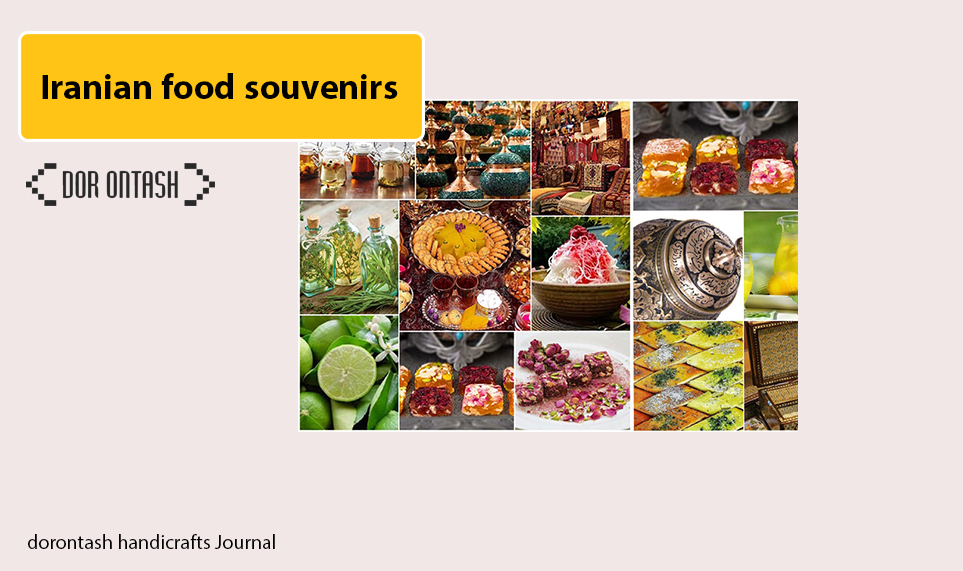The History of art in Iran, regardless of the place and time of its origin, reflects the spirit and desires of Iranians. Another point that seems to be the variety of works of art shows that ancient Iranians had high skills in different regions. “Iranian Art It is one of the richest and most diverse collections of human cultural heritage. Carpet weaving, painting, pottery, architecture, music, calligraphy, inlaying, enameling and wood carving are examples of Iranian arts and crafts.

Art is a very valuable and important category, to such an extent that since the creation of man, traces and effects of its various fields can be found in history. Handicrafts are generally referred to as industries that can be established in cities and villages, do not require advanced technology, and are more dependent on local and traditional expertise. Handicrafts have both consumer and artistic characteristics, they also have insight, taste, thought and productive culture, and they call it a craft .
Iranian art before Islam | History of art in Iran
About 5000 years ago, the states of “Sumer”, “Akkad”, “Babylon” and “Assyria” were established in Mesopotamia near the Iranian plateau, and then about 3000 years ago, the Elamian state was formed on the Iranian plateau.
* The attack of the Greeks led by Alexander led to the destruction of the Achaemenid government, and then the Seleucid and Parthian governments came into being one after the other.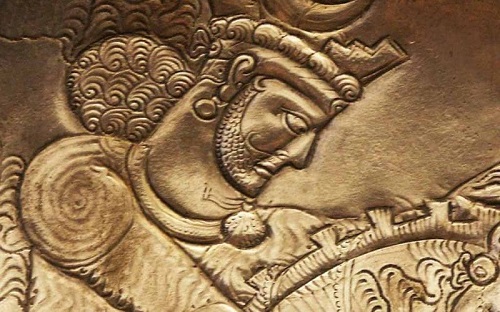
* In the study of ancient Iranian art, we face problems such as: lack of documents, unavailability of obtained works, and lack of attention to research and exploration.
The art of Iran before Islam (the art of ancient Iran) and the art of Iran after Islam, in general, the different fields of this art are: sculpting and embossing, pottery, painting, metalwork, calligraphy and gilding, embalming, carpet weaving and textile.
Understanding pre-Islamic art in Iran | History of art in Iran
The art of ancient Iran has been and still is the attention of many researchers in the world for various reasons. One of the obvious reasons for this attention was the emergence of one of the world’s oldest civilizations in this region. About five thousand years ago, the states of Sumer, Babylon, and Assyria were established in Mesopotamia (between the Tigris and Euphrates rivers) near the Iranian plateau, and then the Eidmian state was established in the Iranian plateau about three thousand years ago.
After that, the Aryan immigrants destroyed the kingdoms of Elam and Mesopotamia by establishing the Median and then the Achaemenid states. The Achaemenid government was also destroyed by the attack of the Greeks led by Alexander, and then the Seleucid and Parthian governments emerged one after the other. After the Parthians came the Sassanid government, which was destroyed by the conquest of Iran by Muslim Arabs.
Another reason for researchers to pay attention to the art of ancient Iran is that the powerful Iranian governments in ancient times used their power to recruit artists from different countries and by providing them with more facilities, they made different art fields grow significantly.
Art in the Achaemenid era | History of art in Iran
The art of Iran during the Achaemenid era was mainly based on honoring the position of the kings of this dynasty, which is a combination of the art of various peoples who were subject to the Persians, and the Achaemenid people made proper use of these different arts and poured all the artistic effects of different peoples and nations into They have elevated a format to their art. In addition to commemorating kings, the performance of rituals and Zoroastrianism is also one of the main manifestations of art in this period, which caused the creation of a kind of artistic symbolism in Achaemenid artworks.
Among other artistic manifestations of this period is the prevalence of carving, sculpting, sculpting, metalwork, tile making and carpet weaving. The remaining works depict the depth of progress of Iranian artists in these artistic fields. The reliefs of Persepolis are also among the treasures of Achaemenid period art, each of which displays a collection of rich images and motifs of the Achaemenid period, and in addition, they are indicative of many customs and traditions common in the Achaemenid court. .
Identification of art in Persepolis History of ancient Iranian art
In the reliefs of Persepolis, there are scenes of ceremonies and rituals common in the capital of the Achaemenid kings, where the king’s body is generally the main focus of each scene. In these beautiful carvings, which are engraved on the heart of the mountain, the groups of gift bearers, the scene of the public bar of the king and other prominent motifs related to the tomb are displayed. At the same time that these carvings all speak of the mastery and skill of the stonemasons, each of them shows a corner of the ceremonies and religious political events of that era. The characteristic of these works is that it shows that the body carving artists of the Achaemenid era were completely in the service of executing and designing their motifs and had no room to express their personal desires, and in other words, they were considered completely obedient.
The characteristic of these works is that it shows that the body carving artists of the Achaemenid era were completely in the service of executing and designing their motifs and had no room to express their personal desires, and in other words, they were considered completely obedient.
Metal works in the Achaemenid period History of ancient Iranian art
The works of metalwork are also prominent and impressive in this period. Achaemenid metal objects are mostly made of gold, silver and bronze, and one of the most important discovered works is a golden chariot with four horses in front of it and two human figures sitting on the chariot bench. An important point in the metal works of this era is the large use of motifs and animal figures in making dishes and ornaments. These motifs can be seen on silver and gold plates in the form of lion and cow fighting or two goats.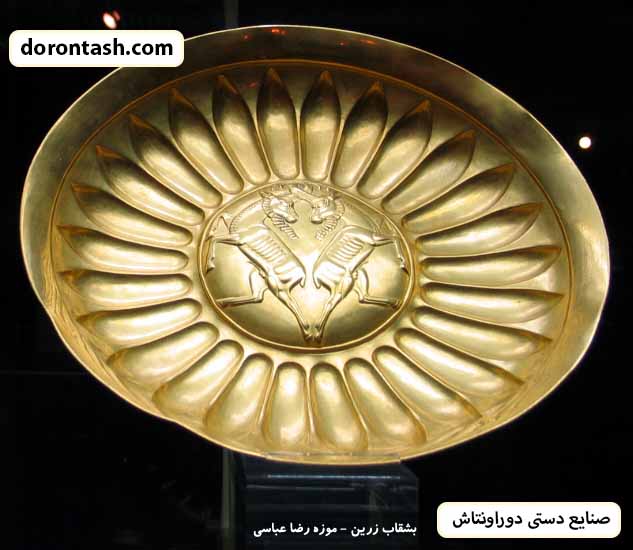
One of the most prominent ornaments of this period are bracelets that end with two lion heads and are decorated with small and pill-like ornaments in the shape of animal and bird heads and geometric patterns. These general works indicate that the Persians were interested in gold, cement and bronze tools during the Achaemenid era and used part of their art in this way.
Carpet weaving during the Achaemenid period
Carpet weaving is another prominent manifestation of Iranian art during the Achaemenid period. This art was not studied much by scientists due to the destruction of most of the Iranian carpets in ancient times, but in the late 1950s, with the discovery of a 1.83×2 meter carpet, which was discovered along with other exquisite works in the ice of Siberia. Another manifestation of Achaemenid art was exposed to the viewers. This carpet was discovered in a place called (Pazyrik) and later became known by the same name. The type of texture, elegance and pattern of this carpet speaks of the skill and mastery of the Achaemenid weaving artists and shows the long-standing tradition of Iranian carpet weaving, which dates back to two thousand five hundred years and maybe more.
Carving in the Achaemenid period
Sculpture is another artistic manifestation of the Achaemenid period. This branch of ancient Iranian art, which was in a way the heir of Assyrian decorative codes, has survived today in the form of beautiful figures of animal kings such as horses, cows, dogs, and lions. Stone masons usually carved people and animals in the form of half-lengths, and in showing historical and political scenes and events, they have always emphasized on making their kings look great. In the remaining works of Achaemenid sculpture, the power of visualization, artistic creativity and precision in choosing the subject can be clearly seen.
A general conclusion about art in the Achaemenid period
In a general conclusion, it can be said that the art of Iran in the Achaemenid era has achieved considerable progress, in such a way that the Iranians absorbed various ancient artistic manifestations of the Middle East and made a special combination of them with authentic Iranian characteristics. The contribution of the Achaemenians in this period was to combine, give elegance, proportion and magnify different branches of art in a way that brought it to the peak of its greatness and glory.
History of artistic events in Iran
5 thousand years before Christ
Iranians who migrated in winters and summers, started to build clay houses, advanced stone tools and added bone parts, household items were painted with red and black colors and baked in fire. would be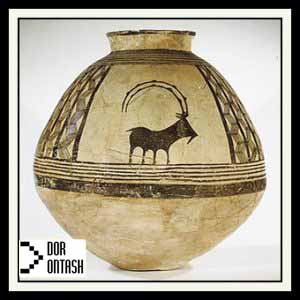
During 4000 BC
Zagros residents built villages and gradually lived densely and architecture was created. War tools in these areas were still made of stone, but at the end of this era, metal swords and daggers, inscriptions with the initial handwriting of Ilahis appeared.
3000 years before Christ
White stone, bitumen and other types of stones were used to make art tools. Dark blue and charcoal sali dishes became popular. Metal weapons were used in different regions of Iran, such as Shush and Nahavand, and various ornaments were made of gold, agate, and lapis lazuli.
Art in two thousand years BC
In two thousand years before Christ, the arrival of the Aryans to the Iranian plateau was the most important event, at that time the art of metal reached its peak of importance, the production of thin pottery spread in Alborz and its neighbors, and luxurious buildings with brick or brick walls were built. Baked pottery was decorated with paintings with designs of humans and constellations, trees and other figures. The developed urbanization and stone work reached a stage that gave beauty to Sush. At this time, tribes such as Aryans, Medes and Persians settled in Zagros.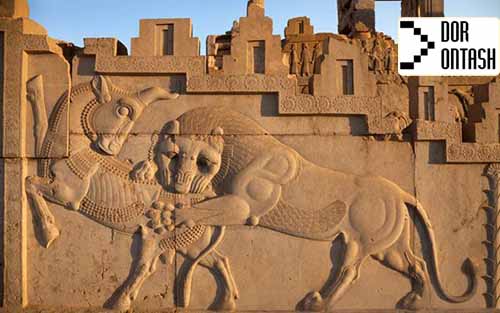
Art in the first millennium BC History of ancient Iranian art
Due to the lack of access to archeological documents, the Black Age is called historical background. New findings provide information about this decade. At this time, rich shepherds and farmers lived in the slopes of Alborz and had valuable metal tools and valuable carved pottery works.
In the 6th and 7th century BC, due to the mass migration of different races to the Iranian plateau, such as Seattle, Oratos, Manila, Castis, Medes, and Pars, and finally the creation of the Achaemenid Empire, and due to the central organization of Iran, it entered the historical era. Since then, the studies have been kept in a timed and classified manner. Inscriptions written in Persian, Elamite, and Akkadian languages remain from the Achaemenid period and show valuable evidence of the greatness of Iran.
Art during the Parthian period History of Iranian art
There is not much information about the art of this period and the discovered works are less helpful due to the unavailability of valid dating criteria, however, the few existing works indicate the gradual liberation of the art of this period from the influence of Greek and Roman arts. During the Parthian period, Iranian art was somewhat inspired and influenced by its previous traditions. However, this art was considered completely Iranian, and although it had deteriorated to some extent in terms of technique and subject matter, it had preserved its national color.
Artists of this covenant according to the time
Little by little, the Greek works of art, which were the product of the rule of Alexander and his successors, were removed from the memory and a new Iranian art was created. Among the important artistic manifestations of this era, we can mention plaster art, which was very popular and its motifs are a combination of Greek and Achaemenid styles. The best stucco artworks of this era have been found on exposed walls in Ashur, Uruk (in Iraq) and Kuche Khajah (in Sistan). The prosperity of plastering art is mainly due to the abundance of mineral plaster and the ease of working with it, which has caused a greater desire to use this decorative method.
Art in the Timurid era
The period of Timurid rule over Iran has been considered as the era of re-emergence of art and literature of Iran and Iranians. During this period, a prosperous artistic movement flourished, which influenced the later periods of Iran, such as the Safavid period. The Timurids were generally art-loving kings and most of Timur’s successors turned their court into a circle of artists, poets and writers. They encouraged artists. Under their support, arts such as calligraphy, painting, binding and bookmaking reached their full development. The most important branch of art that achieved stunning achievements in this period in the history of Iranian art after Islam was painting. Timurid painting grew significantly due to the gathering of artists in the city of Samarkand and was manifested in the great school of that period in the cities of Shiraz and Baghdad.
One of the most famous painters of the Timurid era
There was a Baghdadi artist named Ujanid, whose name was registered as the first miniature with a signature. During the era of Baysanqar Mirza, who was one of the art friends of his time, nearly forty painters, calligraphers and calligraphers were working in the Great Royal Library of Herat and painted many works such as Shahnameh, Laili and Majnoon, Bostan and Saadi’s Golestan. The sum of these works created a new style that became known as “Herat School”.
In the Herat school, the pictures of people are drawn in a small and small way, and the miniatures are executed with simple and undamaged lines. The miniatures in the bicolor editions, which are elaborately calligraphed and beautifully bound and covered, represent the final stage in the evolution of the illustrated edition. In these unique miniature works, the composition and coloring have reached their perfection, and a coherent unity and connection between motifs and shapes has been created. The formal nature and perfectionism of the miniaturization of this period is clear in a few brief features: the repetition of faces with only slight differences in the facial expression and the way of painting, the way of finishing and arranging the plants in the sandy plains of the paintings, the way of showing the trunks of trees. and the arrangement of their foliage and the dignified and heavy posture of human figures.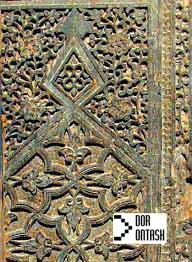
The emergence of Kamaluddin Behzad
The emergence of Kamaluddin Behzad, who founded a school named after him in Herat city, is considered one of the greatest artistic events of this period in painting and miniatures. This prominent artist perfected the special methods of the Timurid school and determined the next path of evolution of Iranian painting. Behzad was the first master of Iran’s nama-saz era, and under his charm and charm, themes such as praising nature in artistic expression, describing precise psychological states, and expressing mystical passion reached their peak.
Behzad’s classic style in painting and his mastery in drawing images and lines with harmony, softness and calmness have made him one of the greatest painters in the history of Iran, who depicts peace and serenity, spring and friendship in his miniatures. drew Among the masterpieces of this great miniaturist are two manuscripts of Khamsa Nizami, manuscripts of Laili and Majnoon, Bostan Saadi, manuscripts of Zafarnameh and pictures of Sultan Hossein Bayqra, a Turkish prince, dervish and thinker, each of which shows the genius of this outstanding painter. .
Calligraphy and calligraphy History of ancient Iranian art
Apart from the art of painting, calligraphy and calligraphy also went through the stages of evolution and reached the peak of its development. During the reign of Shahrukh, his son, Prince Baisanqar Mirza, established a type academy in Herat, which played an important role in the development of painting, calligraphy, and book-related techniques. He gathered artists from all over the empire in his dar al-elam and masterpieces were created under the supervision of this artistic and artistic prince.
Calligraphy developed a lot during this period and master Khwaja Mir Ali Tabrizi invented the Nastaliq script, which later became the most common script in Iran. Master Sultan Ali Mashhadi and Jafar Baisangari were the great calligraphers of that era, each of them tried to identify the methods, lines and rules of calligraphy and copying and left unique works. The greatest calligraphic masterpiece of the Herat School is the book of Khajovi Kermani by Mir Ali Tabrizi in Nastaliq script.
Art in the Sasanian era History of ancient Iranian art
The art of Iran during the Sassanid period is a mixture of ancient oriental art and the heir of the Achaemenid and Ashkan civilizations. During the Sasanian era, Iranian art reached its peak and although it was influenced by foreign influences such as Greece and Rome, it changed these arts based on local traditions. In this period, various factors such as mosaic work, painting on the wall, and plastering were used for the decoration of palaces and buildings, each of which were considered to be special manifestations of the Sassanid era. Also, the art of plastering and plastering became very important.
Artists of that time covered brick and stone walls with a layer of plaster and sometimes decorated them. In some cases, artists made frames from pieces of plaster and created similar pieces in large numbers. The motifs of these plasters consisted of various plant, animal, human and geometric motifs, and sometimes a picture and a scene of a hunting ground, which remains of these works.
The reliefs of this period are also very important, a large number of them are located in the main center of this dynasty, i.e. Farsi province, and some are in other areas, such as Salman and Taq Bostan, Kermanshah. The biggest Sassanid relief is in Firuzabad, it shows a scene of Ardeshir I’s victory over the last Ashkan king.
Sassanid relief
What is new about Sassanid reliefs is their size and breadth as well as their large number. Many of these reliefs are limited to two main themes, both of which have become common since the period of Ardashir I, one is the conferment of royal status by a divine authority, which mainly includes Ahura Mazda, and the other is a scene of the king’s victory. on his enemies Scenes of wild boar hunting can also be seen in the reliefs of Taq Bostan. The reliefs of Taq Bostan are pictures and proofs of the way of life and court rituals, which the equipment and tools used at that time, and even the type of clothes, patterns and patterns of fabrics and ornaments have been shown in the most accurate way.
Carpet weaving is one of the other important artistic manifestations of the Sasanian era
Carpet weaving has been very popular in this period. The Baharestan carpet in the Tisfon Palace of Baghdad, which is woven with silk, gold and cement threads and studded with thousands of jewels, is considered the turning point of the carpet weaving art of that period and the pinnacle of the art of carpet weaving in ancient Iran. The patterns and carpets of this period are full of abstract and geometric images of flowers, plants, animals and birds.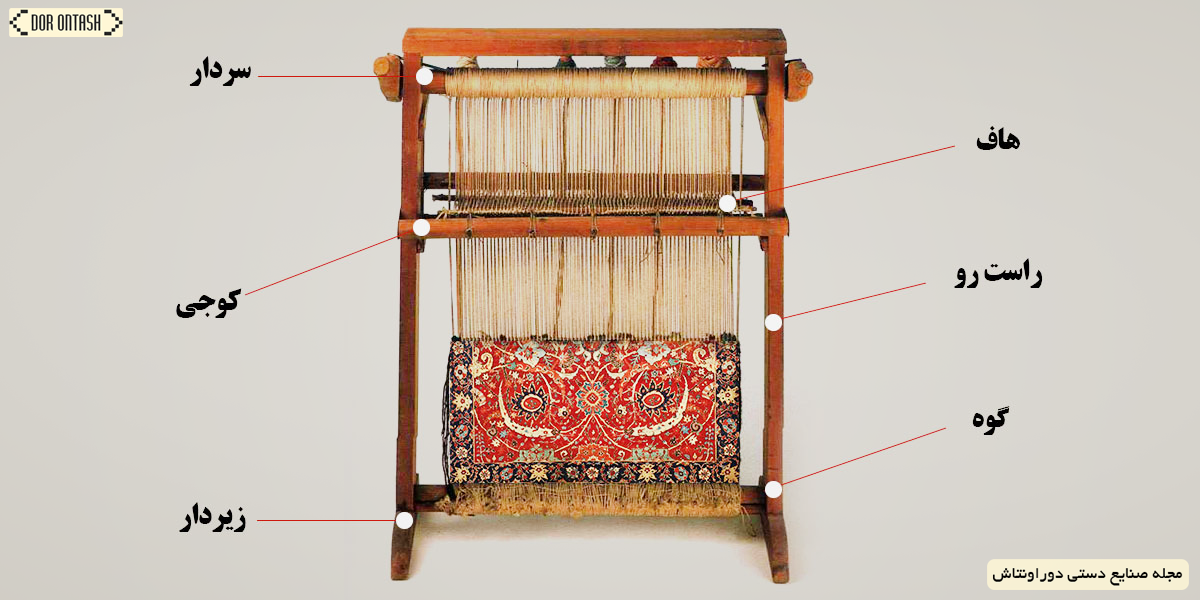 One of the main themes of these weavings is the motif of the garden and hunting scenes, and apparently the garden carpets were so popular and loved by the kings that they even decorated the gardens in imitation of them.
One of the main themes of these weavings is the motif of the garden and hunting scenes, and apparently the garden carpets were so popular and loved by the kings that they even decorated the gardens in imitation of them.
Weaving of silk fabrics in the Sassanid period
The weaving of silk fabrics was also very popular in this period and this was mostly due to the fact that Iran was on the road between China (the largest producer of silk) and Rome (the largest consumer of it) and the route of silk transfer that later became the Silk Road. It became known that he was passing through Iran. The art of metalworking and making decorative metal accessories flourished during the Sassanid era, and in the metal works of this period, such as plates, cups, vases, and ornaments, there are similar motifs of hunting scenes, the sitting of the king, the granting of office, and beautiful pictures of birds, flowers. And a legendary life is observed.
Painting is one of the other important arts of this era; Especially since Mani developed it a lot. Goldsmithing, bronzesmithing, glassmaking, stone carving and painted gems and coinage are other important branches of Sassanid art, which all show the peak of brilliance of Iranian art in this era.
During the 400 years of the rule of the kings of this dynasty, Sasanian art created a manifestation of unity in the face of its diversity and abundance. In this art, although the elements of the arts of other countries and even Roman art can be seen, but its independent identity has been preserved. This is why we can see obvious coherence and homogeneity in all the works of this period.


